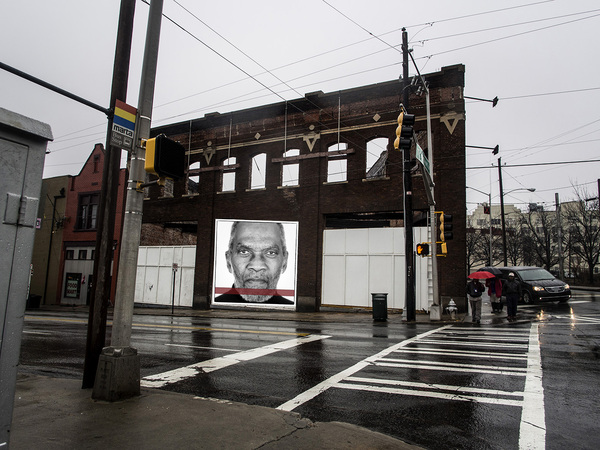I used to wonder what communities would be like without a vibrant arts and culture scene. What would it be like to live in a place where public art, creative programs for the community and visual cultural expression were not celebrated? After traveling to several cities across the nation and globally, it's evident to me that without those things the spirit of the communities and the people in them would not thrive, would not gain economically, and their sense of connection to their communities would not be stagnant -- or even non existent. The arts bring people together that would not normally be connected. It is programs like Atlanta's ELEVATE, a program whose mission is to initiate positive urban growth through arts economics -- or the concept of culture being a driving force for commerce. The theme of this years ELEVATE is "Transit: Time, People & Places" which makes sense because of the substantial growth Atlanta has had in regards to its public transportation and urban accessibility. ELEVATE is an opportunity for both members of the community, artist and local businesses to engage, learn and participate in the transformation of their neighborhood. Atlanta's Mayor Kasim Reed states:
It is with unwavering certainty that Elevate and other creative programs like it, support economic and community development. This program uses the power of art to bring together communities, provide residents with unique cultural and educational experiences and give businesses a vision of potential for downtown Atlanta. I feel the support of our city's arts is vital in maintaining and increasing the vibrant growth in which our city has experienced over the past three years.
I recently had a chance to ask Camille Russell Love, Executive Director of the City of Atlanta Office of Cultral Affairs; and Sheila Pree Bright, one of the several Artist participating in ELEVATE a few questions about this years program..
BWA: Since implementing the Elevate Atlanta Art program, what are some shifts that you've notice happening in Atlanta and the arts and culture scene?
Camille Russell Love: Elevate began in 2011 with the intention of identifying an area of Downtown as an arts place or Cultural District. The Atlanta Art Scene as a whole has grown immensely, and in numerous ways within the past three years. For Downtown, within the past year alone, multiple galleries, design companies & cultural publications have re-claimed downtown as their home lending the natural growth and excitement to the area that comes with creative workers and thinkers. There is a clear boost in the amount of cultural pride displayed by Atlanta citizens and their attendance and participation at cultural events. We are simply becoming a more arts centric city which is proving beneficial for everyone here.
BWA: How do you come up with the various themes for each year's Elevate ATL?
Camille Russell Love: Each year our Public Art staff, alongside the Elevate Advisory Board, selects an area of Downtown that the placement of Elevate will be most impactful. Many variables are taken into consideration, accessibility, streetscape plans, public transportation plans, foot traffic, architectural potential, vacancy rate etc. Following many discussions, the location of the event is selected. Our Elevate staff, curators and coordinators assess the selected location, current events and the artwork submitted and design the theme for that year and plan programs that support that theme to seamlessly present a week of events and artworks that support each other, conceptually.
This year we've selected the theme of "Transit." Earlier in the year, the Five Points Marta Station and Broad Street Plaza was identified as the focus location for Elevate 2013. 2012 Elevate focused on the vacant but beautiful blocks just south of the station -- South Broad -- and this year we wished to connect that artwork and the growing cultural influence as I mentioned above to the natural foot traffic of North Broad, mostly trafficked by students and the business community. The only separation between the two is the station, which could be easily connected with events and artworks.
Luckily, Marta, our main public transportation system was willing to give us access to the station for performances on trains and within the stations, which is really exciting. There have been multiple public and private transportation projects within the city and our residents are increasingly curious as to what that means for them so we developed panels, selected artworks and produced events around this theme. The city is growing and developing so fast we must make an effort to preserve our history and look to the future at the same time, but with the awareness that both are important, which is also a form of metaphorical transit -- time and place.

Image by Shelia Pree Bright
BWA: What are some things you've learned about yourself and about the power of art/photography while working on your '1960 WHO?' Project?
Sheila Pree Bright: I am forever learning as my work engages audiences. During the process of researching the youth of the 1960's and hearing their stories, I realize I didn't know much about the turbulent times of the 1960's. So far, I have learned that this generation had an idea of who they were, but it was shaped by a vision, a struggle and the endurance of a small and diverse group of youth leaders. I learned the youth of the 1960 have untold stories of the Civil Rights era that no one has heard publicly, neither has been presented in a way to truly connect generations. Beyond their pivotal struggle, which was race related, there were also examples of youth culture, trend setting and accountability that I feel can inspire us all. Through still photography, I aimed to capture their endurance and outcome as dignitaries. That's the power of images, to show how our humanity is inner-connected and to create dialogues amongst people for growth.
BWA: What inspired you to create the "1960 WHO" Series?
Sheila Pree Bright: In 2008, I asked Generation Y, "What does it mean to be American in the 21st century?" They wrote short statements and I photographed them with the American flag as a way for them to express their sentiments. Six years later, after the series traveled to museums and galleries throughout the country, I began to reflect upon the social struggles young people were experiencing in our current times: bullying, inland terrorism, hate crimes and child sex trafficking. I identified a connection with the climate of the 1960's, which inspired the "1960 Who" public art series. Although the struggles of the era have a different content, I felt examining this generation would create a beneficial dialogue for our current times.
BWA: What are some of the challenges you've faced in executing this project and how have you been able to overcome them?
Sheila Pree Bright: It was a challenge in considering how to present the street series in a way that would engage spectators cross-generational. Racism is a complicated topic even 50 years after the Civil Rights movement. I did not want present the work in a way that would spark useless conversations or delude the message, which is -- the youth of 1960 bravely stood for their human rights. We all have faced a bully or have demonstrated endurance in overcoming a struggle. I feel the portraits depict this message, and the digital media aspect allows a platform to examine generational perspectives of fighting for an honorable cause in a unified way. My goal in the work is to provoke a critical thought about communities and leadership.
This year's ELEVATE has several events that include live music, readings, photography exhibits, theatrical performances and more from now until October 26. How is YOUR city creatively revitalizing it's communities and the people who live and work in them?
